by Venchito Tampon Jr | Last Updated on November 7, 2021
What is blogger outreach?
Blogger outreach is the process of building genuine relationships with industry publishers and bloggers to find a common point of interest where both ends will benefit.
At SharpRocket, thirty percent (30%) of our work is spent on blogger outreach. Making sure that every email penetrates the inboxes of recipients and secures positive responses, requires us to strategically prepare the outreach list before they are sent away.
In this guide, I’ll walk you through the exact outreach tactics we’ve implemented to our clients plus tools that we utilize to improve the entire process – from gathering contact information to nudging bloggers to link to the content.
Other Definitions of Blogger Outreach
Before getting straight to the how-to section, let me give you some definitions of blogger outreach from what we’ve considered as linker outreach veterans.
Blogger outreach is the process of contacting bloggers through any communication medium for the purposes of collaborating on projects, such as giveaways, content publishing, or sponsored posts.
Ross Hudgens, Founder of SiegeMedia
Blogger outreach is a marketing channel, which involves building relationships with bloggers to form mutually beneficial partnerships. The aim of these partnerships is to effectively promote one’s business, while simultaneously providing value to the blogger and their audience.
Dave Schneider, Founder of Ninja Outreach
5 Blogger Outreach Best Practices
What makes practices best in their natures are small differences that can take mediocre emails to outreach emails that convert into high-value links. When others are looking forward to new strategies or tactics that can be tried and tested for a change, there are small overlooked details you can already apply to create success for your next outreach campaign.
1. Tracking Open Rates With Mailtrack.io.
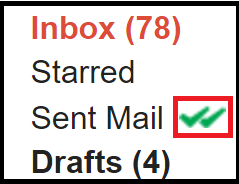
One missing metric of many outreach campaigns we’ve encountered is the open rate. Open rate is basically the ratio of emails opened (whether they landed a coverage or not) over emails sent.
If you are handling several outreach campaigns, you get to overly focus on emails that received responses from bloggers and tend to overlook opportunities from emails opened yet not replied to.
If you can track the latter type of emails, you can build potential equity you would have missed if you remove it from your outreach database or you just follow up with them with the same initial email template.
One best outreach tool that can aid you with this is Mailtrack.io. This blogger outreach tool enables you to know if emails had been sent to their proper places and if the person you’re reaching out to opens your email. This provides you insights to better understand the majority of your outreach prospects. If a person reads your email but didn’t respond to it, you can draw hypotheses from these:
- Your content offering doesn’t cut through the interest of the blogger.
- Your subject line attracts but had no relation to the body of your email.
- Your email is fully promotional in nature.
From this hypothesis, you can take actionable measures which you can read in the latter part of this guide.
Back from the great functionality of the tool, Mailtrack.io offers the said feature for free. So if you are weighing budget with outreach ROI, the tool helps you save product costs.
2. Encouraging Response With A Content Proposition
Mediocre outreach specialists send emails with naked URLs to view their content. Without trying to describe what the content is all about and how it does help bloggers’ readers regarding a topic, the email is near the same as spammy bulk blasts. Both don’t provide enough value.
Instead, you’d want to capture the blogger’s interest by stating the unique proposition of your content piece – know what differentiates your content from others and explicit it. Including social proof in your email also builds credibility to your content – e,g, how many influencers had shared your content asset.
Besides content proposition, there is also one way to leverage interest – that is, visitor engagement. This is often stated in broken link building campaigns which goes like, “If you fix the broken link in your resource page, this will help your visitors find the referenced resource”.
Apply this same principle to blogger outreach. You can structure emails that end something like this:
If you think adding more interview related references to your page can make your website visitors engaged, let me know if you’d like to see it.
With this type of proposition-based call-to-action, you encourage more positive replies from bloggers instead of letting them view only your piece.
3. Leveraging Specific Subject Lines
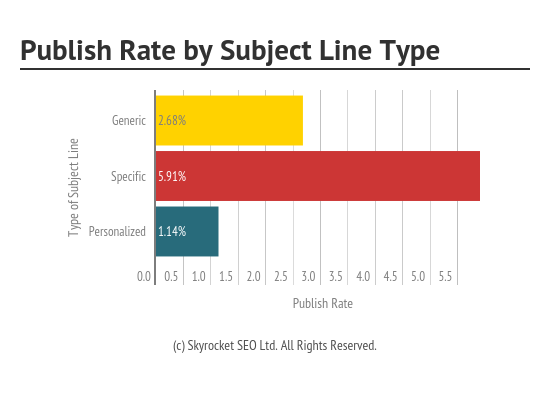
Personalization gets so much attention from the link building community, particularly those whose main task at an agency is outreach. It’s easy to pre-conclude that because an email is personalized, it would help the content earn links instantly.
That’s not always the case. If you’re crafting a long customized email, the person who will be reading this would lose his interest at the start. Brevity lacks in some way.
That said, one good piece of advice here is to segment your outreach list based on priority – identify which bloggers needed to pitch emails with a strong level of attention. For low to medium-level bloggers, you can create an email template with specific subject lines, such as, “hoping to be included in your career resource”, which would only require small tweaks in the email replacing attribute tags such as name, site name, and target page.
In their latest outreach data, Skyrocket had seen no evidence of getting better results by crafting personalized subject lines in emails (see image above). Besides ease in crafting individual emails, there is uniformity among outreach specialists who work on the same blogger outreach campaign. Also, it saves a ton of time.
4. Highlighting Attribute Tags
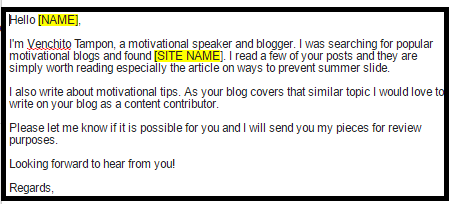
As a company that loves outreach, crafting email copies is essential in scaling the initial blogger pitch, which are structured in such a way it could be customized for certain people. This provides us the luxury to spend more time in relationship building once the conversation started, instead of exerting extra efforts to fully personalize emails.
Keep in mind that because email templates are great, they aren’t prone to some human errors. If you happen to send emails to editors without replacing one of the attribute tags ([name], [site name], etc..), you end up losing the potential equity you would get from the conversation you try to make with the editor.
More so, if you aren’t careful with replacing attribute tags with website details, there are possibilities of receiving replies that say, “that is not my website” or “you should have researched my website first”.
One minor error in tag replacement is a major error in the entire outreach process.
If you value every single outreach prospect, one tip here is to highlight attribute tags when constructing email copies or canned responses, so if you feel you have forgotten one of the details, you can easily skim the entire email draft before actually sending it. If Gmail is your preferred outreach platform, it is a lifesaver option to enable the Undo feature –which helps you to revoke your mistake.
5. Bridging Conversations Through Email

If you’re not maximizing other mediums of communication aside from email, you’re missing out on opportunities that might get you to faster coverage of links.
At SharpRocket, we’ve tested using Twitter in our link prospecting phase and we’ve found great blogs out of it. It also gives us a clue that there are visible industry blogs in this social platform that if we’ll be going to reach out to, we can bridge relationships that can convert into links.
Creativity matters in blogger outreach. If you’re an outreach specialist, you shouldn’t just sit down when you can’t contact the person through email, but find at least two other ways to approach the person.
Initially connect with the outreach prospect using social media platforms like Twitter and bridge the latter part of the conversation through email. There are a few good reasons why I think this workflow works. First, you avoid communication errors caused by email technical issues. Second, you can validate the email to contact to by asking it straight to the Twitter handler (blogger).
Here’s an example of an exact email that shows how this practice works:
Writing this further to our conversation on Twitter (I’m @nirajr). Great to be connected.
6 Blogger Outreach Tools
This definitive guide to blogger outreach isn’t complete without tools that can aid you with the entire outreach process. So here is a list of tools that I highly recommend and we have actually used and tested for our clients, which you can also try to take your campaign to the next level.
1. Email Hunter
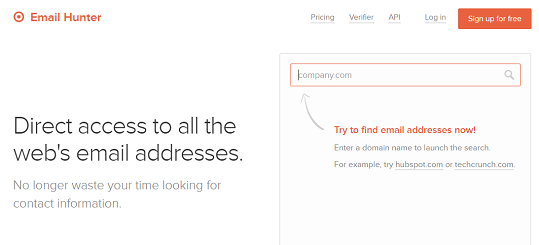
Email Hunter is a great freemium tool in finding email addresses without actually dumping to each individual pages of the website to collect the contact details. It’s definitely a time-saver tool for bulk lists of outreach prospects that might need hours for manual searching of email-addresses.
However, when Email Hunter pulls out data, it would provide a long list of contact emails, so you have to manually choose which email to contact to (preferably this kind of email format – name@domain.com). Later this guide, you’ll learn about our list of prioritized email formats that respond to pitches we make.
2. MAIL TESTER
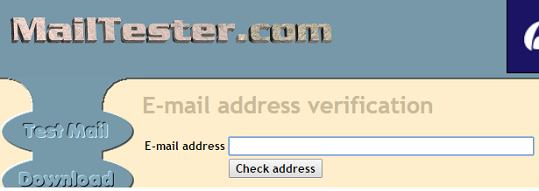
If you’re doing blogger outreach for years, you probably would agree with me that an outreach campaign usually comes with “Mailed Delivery Messages”. If you skip these errors and you try to find secondary emails to replace them with, you can consume some minutes, which should have been used for other outreach workflows.
You can avoid said type of messages by validating emails before you actually pitch them. Mailtester does help determine if emails are of good use, which minimizes your time searching for secondary-level emails.
3. BUZZSTREAM
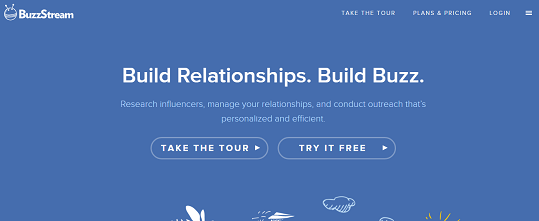
If you land on a website and you want to contact the blogger straight from the browser, you can do so with Buzzstream’s Buzzmaker tool. The tool gives you the luxury to execute immediate blogger outreach without using the main outreach dashboard.
Buzzstream lets you also track emails that converted into links and enables you to label emails with specific relationship levels, so you can monitor which ones should be prioritized.
The said tool works effectively for large teams of link builders and outreach specialists.
4. PITCHBOX
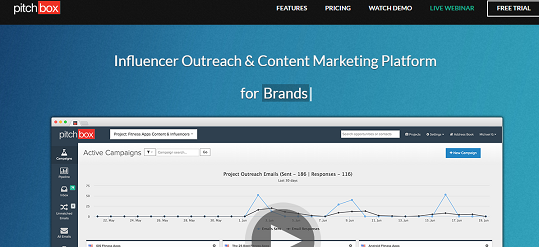
Designed for small teams of link developers, Pitchbox allows you to automate follow-ups and consecutively send them to bloggers with a set amount of time interval between each follow-up. If there is no reply within the first days after an email has been sent, the tool sends another follow-up email – which takes away the trouble of checking if the next set of follow-ups cut through the inboxes of outreach prospects.
Additionally, Pitchbox’s difference-maker is the ability to create pre-built reports – a definite time-saver for outreach managers wanting to grab email data (i.e. number of email responses vs number of emails sent). Instead of manually computing these numbers, you can automate the reports by clicking on buttons.
5. NINJA OUTREACH
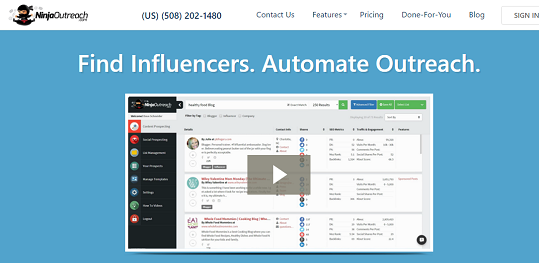
Ninja Outreach’s handy feature from a blogger outreach perspective is allowing you to pre-fill contact forms with email templates upon visiting contact pages of blogs. If you guaranteed that a certain person is qualified to reach out to, the said feature of Ninja Outreach saves you time not revisiting them for future outreach.
Generally, if you have a basic to intermediate level knowledge in the overall blogger outreach process, the tool has an easy user interface that helps you execute everything from link prospecting to email outreach.
6. MEME GENERATOR
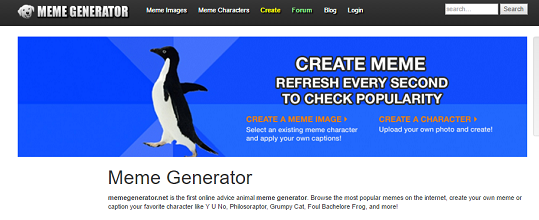
For saturated niches where bloggers receive dozens of emails every day, it’s ineffective to send emails that almost look like other blogger pitches. While it’s true that content can speak for itself, transitioning your emails from good to great necessitate your email to stand out.
One way to do this is to tweak some parts of your email that will add humor to your message but still encourages bloggers to respond to your pitch (see image below) – hat tip to @seoteky.
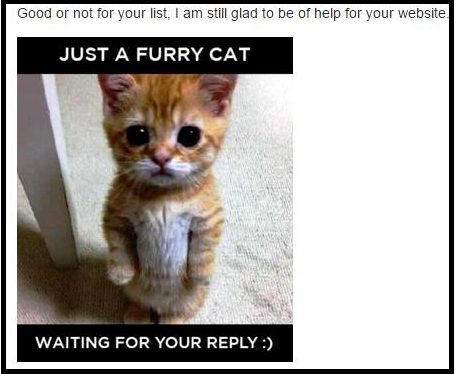
THE SCIENCE BEHIND EFFECTIVE BLOGGER OUTREACH
Data, in particular psychology studies, leverages the results of the entire workflow of blogger outreach – as it reveals things that needs improvement or removal and helps plan strategies that almost-predict results in the next campaigns.
Below is a curated infographic of external research studies generated from analyzing thousands of emails sent to different people. This will definitely help you craft outreach emails that guarantees more than average success.

Share this Image On Your Site
If you’re looking for more supporting data of this infographic, here are the step-by-step breakdown on the science behind effective blogger outreach.
USE CC FOR TWO RECIPIENTS
When gathering contact data of publishing sites, you mostly see that twenty percent (20%) of these blogs are coupled with multiple authors and/or team of editors. This may raise confusion on which one of these people you should be reaching out to.
At SharpRocket, we had a solid chronological preference on which email should be collected first.
- Visible email – find the most visible contact email on the page (for resource page) or on contact pages – domain.com/about or domain.com/about-me (for blogs).
- Personal email (e.g. venchito@digitalphilippines.net). Use Rapportive or Clearbit to validate if it’s the actual email being used.
- Contact page of the sole author
- Department / Position-based – identify the person who is capable (at most) of accessing the website and editing the article/page.
- admin@domain.com
- editor@domain.com
- info@domain.com
If there are several emails to choose from, collect two of them and save it to your database.
In the study conducted by Yesware, they’ve found out that emails sent to one person while cc’ing another are 12% more likely to get response than email sent to two people.
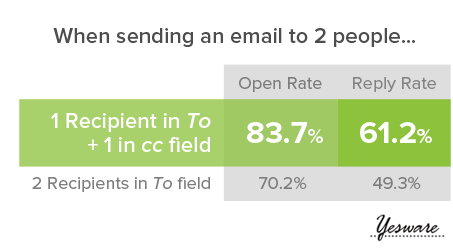
The probable reason for this is that the one person who directly receives the email has the responsibility to take an action, because there’s another person looking at the email. This also encourages the other person to reply if the primary action doesn’t take place. Needless to say, you can receive more response by only sending an email to one person while cc’ing the other recipient.
One quick note here is do not try to get the following email formats from prospect sites, as emailing them would directly go to support, customer service or sales group – they won’t take time if your pitch isn’t product-related.
- sales@domain.com
- support@domain.com
- service@domain.com
- hello@domaincom
- office@domain.com
The next best option when these emails are only available in the website is to grab the site’s page where it locates the contact form. Then direct your pitch through that form.
MAKE SUBJECT LINES CONCISE
ReturnPath shared an interesting study on subject line usage, which shows that 49 subject line characters or less gets 12% open rate and 75% CTR higher than those with 50 characters or more.
This may require immediate testing to make results possible for your campaign, but in essence, the reason it works is the brevity of the subject line.
Make your subject lines straightforward so busy bloggers could get the whole point of your message – definitely makes your email stand out.
REFERENCE PAST ENGAGEMENT
What most link developers or SEOs didn’t truly understand about relationships, is its ability to create a flywheel of links with low maintenance cost and efforts. When you connect to publishers, particularly those that gained mutual content benefits, it’s a less hustle to distribute a newly-released content to a target audience if you have a network of publishers to promote your resource.
Use this to your own advantage.
A smart outreach strategy starts an email with a reference to any past engagement with the publisher. Whether it’s a Twitter conversation or a recent offline interaction, a statement indicating a relationship gives a cutting edge to outreach results.
Buzzstream and Fractl found that 66% of publishers are more likely to open an email with a subject line referencing a past relationship. This added small detail to subject lines makes a big impact, if executed properly.
PERSONALIZE SALUTATION
If you want to get higher ROI from outreach efforts, personalization is a must-have rule when crafting an email. While this part is a no-brainer, many still ignores its power. If you send a pitch to email formats like editor@domain.com, when the site has its own about me page, it’s easy to conclude that you didn’t spend a minute researching even just the name of the blogger.
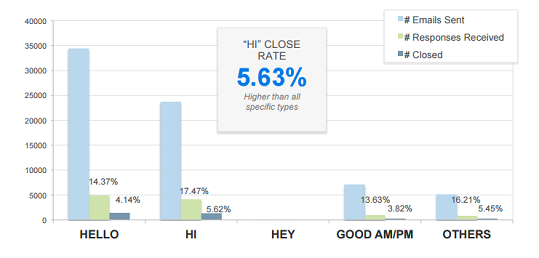
Additionally, using “Hi” as your greeting can improve close rate 5.63% over all other specific types based on iAcquire’s lessons in analyzing 300,000 custom outreach emails. There is no particular conclusion from this, but somehow reflects on the idea that greetings like “Hi” is commonly used in normal conversations.
WRITE SHORT EMAILS
Brevity in subject lines complements with short body email messages. Among thousands of emails, SiegeMedia concluded that the highest converting email length is an average of 83 words. Their hypothesis? Short enough to be easily readable, long enough to be customized.
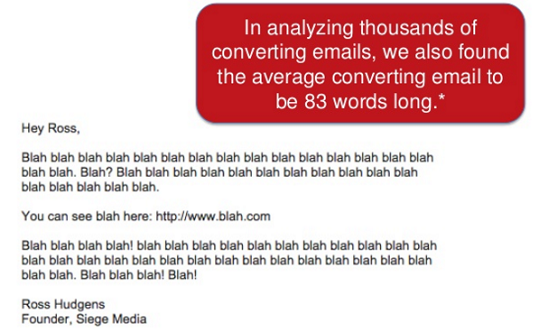
Be careful though when you customize email copies and before hitting the “send” button. You can get messed up by not replacing attribute tags (i.e. {Name} and {Site Name} or using two email templates in one email – one copy is at the bottom of the email (not visible at first glance).
USE SOCIAL PROOF
In email outreach, mentioning a social proof in the body of an email breaks the stranger barrier between the sender and the recipient.
When you include a mutual connection in your email, either a colleague, decision maker, influencer or popular publisher, it signals that you valued the opinions of others. This takes cues that you’re being related to a particular person they might know, which easily builds trust.
Studies of Yesware show that emails with social proof get 33% reply rate. Content-wise, if you’re being asked to promote a certain content, you wanted to know if the resource has gained some traction already, guaranteeing shares and additional links to your site when it is promoted.
A few social proof examples that are worthy to be mentioned in your email:
- 3000+ shares on a piece you’ve shared recently
- Contributor’s badge for a large publication site
- Number of publications or media exposures you’ve been featured in
- Name of industry experts you collaborated with
INCLUDE TRUST SIGNALS IN FOOTER
Aside from social proof, there is also one trust signal that can drastically increase your campaign’s link acquisition rate – that is, branded logo. If you’re reaching out to bloggers in behalf of a client or your company, adding a branded logo to your email makes success possible.
A few statistics to consider, gathered from iAcquire’s outreach case study:
- Emails without logos – close rate at 3.72%
- Emails with embedded logos – close rate of 6.03%
- Emails with linked logos – 10.58%
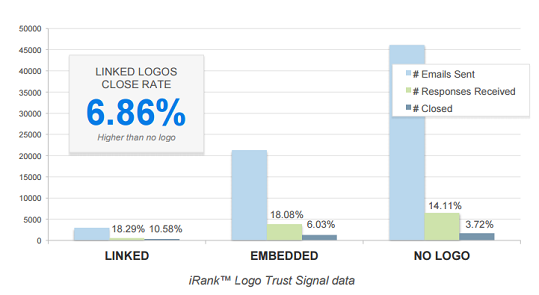
If you’re working in an agency as an outreach manager, ask permission from your clients first before sending emails to bloggers with embedded company logos. Some white-label clients don’t want their brands disclosed in the blogging community – outreach specialist will act as a generic content marketer finding the resource worthy to be promoted.
SEND EMAILS EARLY MORNING
Bloggers either full-time writers, in-house specialists or business owners have their own specific hours in a workday to check email inbox. Taking advantage of this increases the chances of your outreach emails being opened. So the next time you pitch bloggers for any reason, consider the best day of the week and best time of day where they’ll likely see and prioritize your email.
Buzzstream and iPullRank found that email sent between 1AM and 9AM return the highest placement and response rates. Hypothetically, if you schedule emails in this range of hours, you’ll increase the chances of getting your emails read and prioritized by your target bloggers for emails responses.
Additionally, pitching emails at best email reading days converts better than them on any particular day.
In the recent study by SiegeMedia, it shows that Monday is the best day to send initial outreach emails among other days. Monday emails also converts 80% better than Thursday.
In my opinion, Monday works best primarily because it is the start of the working day. Bloggers have the energy to respond to as many relevant emails they supposed to answer.
WITHHOLD LINK IN INITIAL EMAIL
I’m not a fan of being aggressive with email outreach. We usually pitch customize emails explaining why our content piece is worthy to be read and shared. Emails don’t include a naked link to view the content but rather just asking bloggers if they are interested to take one look at the resource.
SiegeMedia has the same approach with us of forgoing the link, to “catch and hold” the interests of bloggers. Once the interest has been captured, the next step is to maintain it. .
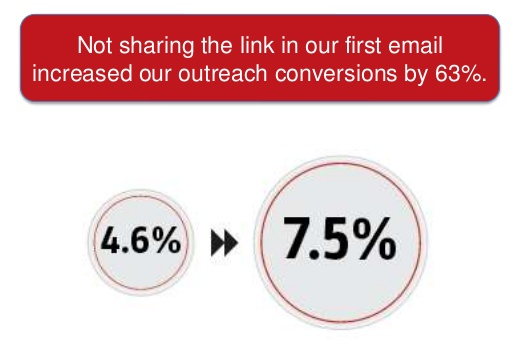
Starting the conversations first and keeping their interests until they decide to reference the work/resource better results to links than carelessly landing an email that gets to auto-spam filters – another reason why withholding the link in the initial email is preferred.
FOLLOW UP PEOPLE
Hubspot found that 50% of emails are opened in the first 24 hours. After 24-hour timeframe, 80% of emails were opened within 12 days of being sent.
If you didn’t receive any response after the initial outreach, you can follow up bloggers to increase chances of getting additional responses.
A silent conversation is worse than a solid “no” response. If you don’t get a response, you are stuck with a decision whether to continue the conversation or proceed to another prospect in the list.
If you decide to send follow-up messages, be mindful that too much of it can irritate the blogger – potentially can burn bridges along the process.
One way to avoid this is to send one last follow-up message to know the reason why they never had a chance to get back to you.
At SharpRocket, we send an email listing down three common reasons of silence and encouraging bloggers to choose one.
Here’s an email template we send to publishers.
Hi [ Name ],
I haven’t heard back from you, and that tells me one of three things:
1) You’re not interested at this time, but we can work out something in the future.
2) You’re still interested, but haven’t had the time to get back to me yet.
3) You saw our content but you think it’s not fit to add to your page.
Please let me know which one it is, because I’m starting to worry. If you have other reasons, please let me know so I can stop bothering you.
Thanks and looking forward to hearing from you.
[ Name ]
This follow-up email enables us to act on issues immediately, such as:
- Get back to the blogger when there’s another content/resource to offer.
- Schedule a custom follow-up to get an update after some time (for case 2).
- Improve content based on the feedback of the blogger (for case 3).
Based on our data, 70% non-respondents to first email would reply to a follow-up message above. This saves a lot of time for outreach specialists as they don’t need to reach out to the prospect again if the blogger decides not to be contacted again.
FURTHER READING:
Blogger Outreach The Right Way
Have We Been Helpful?
Want to take your link building to the next level – — but don’t know where to start, and are feeling overwhelmed by this post.
We are here to help you. SharpRocket is a team of link building specialists who love building high quality links.
To learn more about how we can help, take a look at the services we offer.
The Author
Venchito Tampon Jr
Venchito Tampon is a Filipino Motivational Speaker, Corporate Trainer, and a Leadership Speaker in the Philippines. He is the CEO and Co-Founder of SharpRocket, a link building agency. With a decade of experience, Venchito has a proven track record of leading hundreds of successful SEO (link builidng) campaigns across competitive industries like finance, B2B, legal, and SaaS. His expert advice as a link building expert has been featured in renowned publications such as Semrush, Ahrefs, Huffington Post and Forbes. He is also an international SEO spoken and has delivered talks in SEO Zraz, Asia Pacific Affiliate Summit in Singapore, and Search Marketing Summit in Sydney, Australia. Check out his other businesses, Hills & Valleys Cafe, Blend N Sips and Saas Pursuit.
How our LINK BUILDING AGENCY builds 250 links/mo consistently using Predictable Link Building Methodology™…
- Using a SIMPLE and PROVEN system
- Using a SCALABLE strategy
- No private blog networks
- No creepy outreach emails


